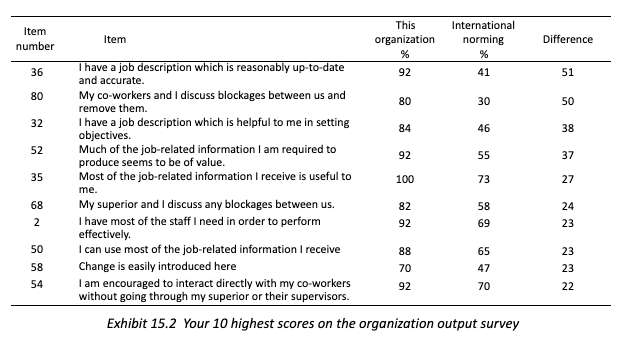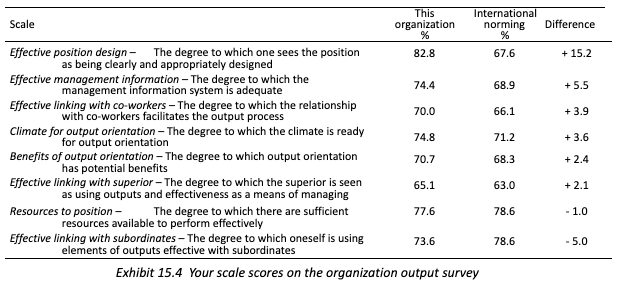¿Qué encontrarás en este artículo?
ToggleWilliam J. Reddin
It is now possible to determine accurately the degree of output orientation in an organization, to identify the stronger points and to see what weaknesses need to be changed. An 80-item survey, the Organization Output Survey, has been designed to do just this. The Survey consists of eight scales, each with 10 items to which the respondent replies ‘yes’ or ‘no’. Some organizations use it annually as a measure of the degree of output orientation being obtained. Some have used it for several thousand managers.
This chapter will describe the survey, and several of the items composing it, and give actual results from one large multinational. Together, these will give you an opportunity to think about what you may want to measure in your organization as a whole, or in your part of it, it will also provide you with an opportunity to test your ability to make a diagnosis of what is wrong and right concerning outputs in a particular organization using the survey data provided here.
The organization output survey
The eight scales of the survey
The survey measures eight characteristics of organizations. These characteristics have a scale of 10 items. The eight scales are:
Effective Linking with Superior: The degree to which the superior is seen as using outputs and effectiveness as a major means of managing.
Effective Linking with Subordinates: The degree to which oneself is using elements of outputs and effectiveness with subordinates.
Effective Linking with Co-workers: The degree to which the relationships with co-workers facilitates the output process.
Effective Position Design: The degree to which one sees one’s own position as clearly and appropriately designed.
Resources to Position: The degree to which there are sufficient resources available to perform effectively.
Climate for Output Orientation: The degree to which the climate is ready for output orientation.
Benefits of Output Orientation: The degree to which output orientation has potential benefits.
Effective Management Information of Output Orientation: The degree to which the management information system is adequate. (This scale is given in full in Chapter 13).
Basis for norms
A survey is of little value unless there is some form of baseline comparison that is realistic. With no such baseline on a ‘yes-no’ questionnaire, the assumption is that 0 is low and 100 is high, little else can be assumed. The norms given here for the survey are based on a wide variety of large and small companies and thus represent what might be seen as a reasonable organization average. Without such there is no way of knowing whether 52 per cent agree to an item such as, ‘Most of the job related information I receive comes in good time’ is good or poor.
Format of survey
The format of the survey is along these lines with the 80 items being numbered and an agree-disagree response requested (see Exhibit 15.1).
Continual update of norms
Users of the survey are asked to provide information on the percentage of their respondents who replied ‘yes’ to any item and in this way, norms are continually enlarged and improved.
Survey uses
The survey is used by the Reddin Organization to obtain a diagnosis on the state of affairs in a company and to provide ideas on what things could be changed that could produce the greatest leverage in effectiveness improvement.
The multinational’s survey
The organization referred to here as ‘multinational’ is a European firm with extensive manufacturing facilities at several locations in Europe and in over 15 countries outside Europe. The total workforce is over 50,000 about 30,000 of whom are in Europe. Those completing the survey include 116 managers outside Europe. The survey was conducted several years after the implementation of a formal MBO programme which was thought to be based on outputs and which was seen as effective. The firm worked to integrate more of outputs and more of teamwork into its programme and a still high level of candour. It commissioned the Reddin Organization to conduct a survey preparatory to a one-day meeting in which the future emphasis on outputs and planned change was to be decided. The 268 top managers completed the survey.
Your task for this chapter is to read over Exhibits 15.2 to 15.4 which cover the highlights of the strengths and weaknesses of the multinational, and to make your own assessment.
Exhibits 15.2 to 15.4 give three pages of a computer printout giving the survey results on the organization. Other pages of the printout gave particular scores on every item, one scale to a page, with each scale containing the 10 items.
You may well see some inconsistencies across the scores. Nevertheless, these scores do represent what the individual managers, in aggregate, replied. They represent the reality as they see it.
Other diagnostic input
There are two additional items about this company which you may want to think about before you make your own analysis. These are:
- In-company feelings before the survey was conducted
- The overactive role of the management development advisor (MDA)
In-company feelings before the survey was conducted
In a document distributed by the CEO some time before the survey was conducted, the two following points were made. They gave the managers’ perceptions of the system being used and the CEO’s reaction to these perceptions.
The two criticisms leveled at the system give a fairly good indication of the problems in it. Aspects of these are picked up by the survey. Note that the CEO’s reactions to them appear to be rather defensive. People were not being considered as much as they might be.
- This is a rigid system which will destroy flexibility and stifle initiative.
There is no doubt that any system wrongly applied can do this, but this is not an inherent characteristic of the system. Properly applied it should identify where flexibility is required and promote it. Furthermore, this encourages the widest possible constructive participation and channels initiative into those areas of most significance to the business. - This is a mechanistic paper-intensive system.
Again this can be true if the purpose of any system is misunderstood. The system should promote the change necessary to achieve results and improvements and as such the paperwork involved is only a means to an end and should be kept to a minimum. Unless this is understood the mechanics and the papers can become the end rather than the means.
The overactive role of the management development advisor (MDA)
The company produced a thick guide to implementing their system. A key figure in the system was the Management Development Advisor (MDA). This was, supposedly an advisory position with no power. But look at the role provided for the position.
- Purpose of the MDA
The MDA’s primary purpose is to help line and staff managers introduce our management system. Some organizations have attempted to introduce outputs without the help of advisors but this places a heavy burden on management to acquire on their own, expertise in our philosophy, methodology and disciplines which are essential prerequisites to adopting this style of management. Without an MDA managers would take much longer to operate within the framework because they have to learn from trial and error. If too much time is taken in getting the system working many of the benefits can be lost through frustration. - Role of the MDA
Briefly stated the role of the MDA is to:
- Assist managers in the formulation of their objectives –to act as a catalyst and counsellor.
- Help prepare managers in the formulation of their reviews.
- Provide advice on all matters concerning the system.
- Ensure that the company and unit key results areas are revised to reflect changing needs.
- Help clarify joint responsibilities through the conducting of management matrix exercises.
- Ensure that schedules are met –management guide agreements and reviews with the managers’ supervisors.
- Make the programme responsive to the needs of management.
- Provide the necessary documentation to enable managers to carry on the programme.
- Plan, control and monitor the progress of our system throughout the organization.
- Form an effective working relationship with the organization’s management.
- Ensure a thorough understanding of our system.
- Evaluate the effectiveness of our system.
Criticism of the role
There could scarcely be a poorer description of the proper role for the management development advisor. The role takes the initiative from the line and involves so-called knowledge workers or sytaff experts where only line managers should tread. The definition of this role as explained above flies in the face of anything we might know now about authority. It is obvious that the MDA reported to the CEO. Equally obvious, this happened because the CEO could not get the immediate team as he wished. so, he added a hitman.
The organization’s ten high scores on the survey
Exhibit 15.2 gives the 10 highest scores the organization received on the survey. The first item, 36, reads: ‘I have a job description which is reasonably up-to-date and accurate.’ Ninety-two per cent of 268 preople replying in this multinational agreed with this item. The international norms revealed that only 41 per cent of managers do, overall. A difference of 51 per cent is shown in the last column. Read over these 10 differences and consider the strengths of this organization.
These 10 statements show, in order, how your organization most differs, in a positive direction, from others. They may reasonably be taken to show what your organization is good at.
The organization’s ten low scores on the survey
Exhibit 15.3 gives the 10 lowest scores the organization received on the survey. Read over these 10 differences and consider the weaknesses of this organization.
These 10 statements show, in order, how your organization most differs, in a positive direction, from others. They may reasonably be taken to show what your organization is good at.
The organization’s ten low scores on the survey
Exhibit 15.3 gives the 10 lowest scores the organization received on the survey. Read over these 10 differences and consider the weaknesses of this organization.
This list shows, in order, the scales on which your organization is better (+) or poorer (-) than other organizations.
Your assessment
Based on your review of Exhibits 15.2 to 15.4, make a few notes on how you see this company and its degree of output orientation. The idea is to try to connect some of the higher scores with lowest scores, and so on. Try to read something into the 20 items that are provided, and try and make some sense out of it all. It is a reality for an organization as seen by its members.
If you were a consultant what would you recommend this company do to improve things?
Some diagnostic comments on the multinational
Before reading these diagnostic comments, you might want to consider or reconsider your own based on your analysis of Exhibits 15.2 to 15.4.
There seems to be indications that individual positions considered in isolation are well designed but these link fairly poorly to other positions, in particular subordinate positions, and link fairly poorly to such things as management information and resources.
The system they are using appears to work fairly well top-down but not so well bottom-up. This can be seen as an inconsistency because middle managers are in both positions. However, it is the superior who is most responded to, not subordinates.
A central problem is linkages with other parts of the organization. This is reflected in comments about co-workers, subordinates and information.
We can see that while a great deal of effort was made to clarify the individual position not so much attention was paid to making the necessary changes in the management information system. There are several very low scores on management information system relating specifically to timeliness, amount and ease of obtaining.
It may be an over interpretation of the data presented here but there seems to be an impression given that a fairly good system has been designed and the issue now is to make it work.
The request for this survey came, in part, because of an observed need to improve teamwork. In fact, this request came in response to an article that was published by the author along the lines of Chapter 6. It may be that they saw teamwork as a useful way of getting a system to work better by providing linkages.
Action steps
- This chapter was designed to put you in a diagnostic mode. It could be a very good idea if you got a few of your co-workers or subordinates or superior to review the information given here and to come up with a group diagnosis.
- Consider whether you should make some survey of the system with which you are immediately involved.
Taken from the book: “The Output Oriented Manager”,
by W. J. Reddin, Part IV – Case Studies, Chapter 15,
Published by Gower Publishing Company Limited, England, 1989; pp. 285-294.












